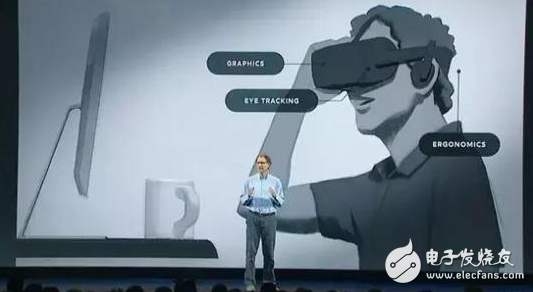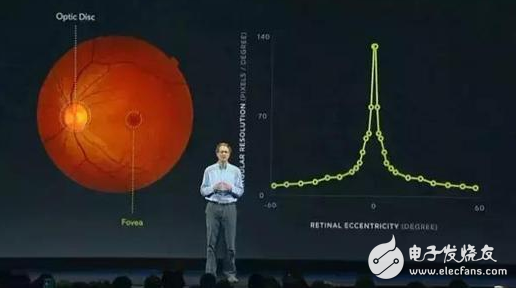At the Oculus Connect conference last month, O's chief scientist Michael Abrash's Keynote topic is the development of VR in the next five years, which involves VR head resolution, spatial sound effects, VR interaction and so on. Compared to the average pheasant expert, Abrash's prediction is worthy of everyone's attention.
Vision: Future Monocular 4K FOV 140°At present, high-end heads such as HTC and Oculus can achieve an angle of view of about 100°. The resolution of a single eye is around 1080*1200, which is equivalent to 15 pixels per degree. The human eye can reach 220 degrees. The angle of view is about 120 pixels per degree. Abrash believes that the current display and optical technology is still difficult to achieve this standard (forgot 4K, 8K, which is equivalent to 24K single eye).

In the next 5 years, Abrash predicts that we can increase the number of pixels per frame to 30, and the field of view will be expanded to 140°, which means we can use almost single-eye 4K*4K display, and now it is fixed in the head. The depth of focus will also be upgraded to be variable, which means that the display and optical technology must be upgraded.

Wanting to render at 4K*4K 90 frames/sec has high requirements on machine configuration. In order to achieve this standard, the success of line-of-sight tracking technology is a must. Focused Rendering - Fully high-definition rendering of images that fall in the fovea of ​​the human eye, while reducing the rendering accuracy of other parts, can greatly reduce the stress on rendering.
However, in order to complete the focus rendering, there must be near-perfect eye tracking technology. Because of the human pupil, the eyelids are different, and there is a system to adapt to the eye movements of the mass consumption. It can be said that it is extremely difficult. challenge. But Abrash believes that we should be able to do it in the next five years.
Sound effectHead-related transfer funcTIons (HRTFs) will enhance the realism of location sound. OculusRift's current 3D sound effects enable real-time HRTFs through head tracking, but this is universal. People use different sizes of torso, head and ears. If they have private HRTFs, they will greatly enhance the sound effect.
Abrash didn't disclose how to make private HRTFs. It is said that a quiet room is needed, but anyway, science teaches that everyone will have one in the next five years. In addition, Abrash also expects people to develop better sound emission and diffraction models in the future to make the sound more realistic. Sound effects are even more difficult than visual effects, and Abrash believes that people can't do much in real-time analog sound over the next five years.
Interaction: Touch will become the mouse of VRScientists believe that a first controller like the Oculus Touch will be the default controller for the next 40 years, just like the current mouse. Future controllers will have improved comfort and precision, but the general shape will not change much.
Abrash believes that gesture recognition will become the standard in the next five years, and its accuracy will be improved to reflect hand movements in VR social. Gesture recognition technology will allow the user's VR avatar to correctly express themselves, and can complete simple instructions without a controller, such as browsing the Internet or opening a movie.
Of course, what Abrash didn't say is that people are still accustomed to and accustomed to manipulating a real physical tool, whether it's typing or playing games, even in VR, given that people are too familiar with previous interactive tools such as mice, keyboards or handles. .
VR heads will become lighter and lighterAlthough the resolution and field of view of the VR head will increase, Abrash believes that the future of the head will definitely become lighter and lighter. In the future, high-end VR heads will become wireless. Of course, we have heard too many times that people say that wireless heads cannot perform high-level operations due to their computational and transmission capabilities. But scientists believe that wireless heading is possible due to advances in focus rendering technology.
Enhanced Virtual Reality Augmented VR
Next, Abrash explains how to bring the real world into the virtual world, an "enhanced virtual reality" where users can scan the real environment and render a fairly realistic picture in the header; or they can enter other user renderings. In an environment, that is, you can place users in any environment, blurring the boundaries between virtual and reality.
Getting a consumer-grade device to scan and render a fairly real environment doesn't sound like an easy job, but Abrash believes that we might be able to do it in the next five years, he believes that augmented virtual reality (AVR) and augmented reality (AR) Very different, the latter is superimposed on the reality level, while the former can control any pixel in the environment for more precise manipulation.
The horror valley effect is still difficult to crossThe most attractive part of enhancing virtual reality is the ability to share the environment with people from different places. However, how to restore people in the environment is a great problem. Even if the future gesture recognition is as accurate as the data glove, the unmarked face and body tracking can be achieved, and it is still difficult to restore the real movements and expressions of human beings.
Because humans are so good at capturing the same kind of subtle facial expressions and small body movements, it is difficult for us to overcome the "horror valley effect" in the next 5 years - in order to let users feel that they are facing a real person in the VR environment, It is estimated that it will take decades. In contrast, Oculus's upcoming avatar system is just a very early stage.
postscriptLighter head display, 8K display, eye tracking and focus rendering, enhanced virtual reality, I don't know if Abrash predicts VR after 5 years and everyone thinks it is the same. If you remember correctly, Digi-Capital had predicted that the VR market would reach $30 billion by 2020. I don't know if Abrash predicts the hardware level and can support a $30 billion market. But O's predictions from scientists are still very clear, that is, the speed of development of VR hardware and software may be slower than everyone thinks.
Heater Thermostat,Cooler Thermostat,Us Type 120V Infrared Heating Thermostat,Us Type 15A Infrared Heating Thermostat
Yuyao Huijun Electrical Appliance Co., Ltd. , https://www.yyhjdq.com